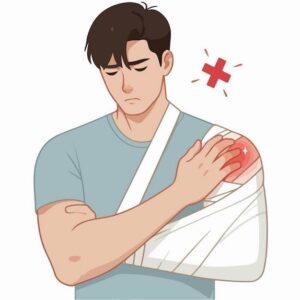Demystifying SLAP Tears: Insights into Shoulder Injuries and Recovery.
1. Introduction
Shoulder Injuries can significantly impede daily activities, including leisure and work-related tasks. One of the most common, although sometimes misdiagnosed, shoulder ailments is a SLAP tear, short for Superior Labrum Anterior and Posterior tear. The cartilage ring (labrum) in the shoulder joint is damaged in this injury, which is commonly linked to trauma or repeated motion. Knowing about SLAP rips is crucial for early detection and successful treatment, whether you’re a worker, athlete, or someone with inexplicable Shoulder Injuries.
2. Understanding the Shoulder Joint
One of the body’s most intricate joints is the shoulder. It functions as a ball-and-socket joint, with the humerus (arm bone) fitting into the scapula (shoulder blade). By deepening the socket and supporting the rotator cuff muscles, the labrum, a ring of cartilage that encircles the socket, is essential to shoulder stability. A SLAP tear occurs when the top portion of the labrum is ripped, affecting both the anterior (front) and posterior (back) regions. The shoulder joint’s stability and functionality may be jeopardised by this disorder.
3. Causes of SLAP Tears
SLAP tears can occur due to various factors:
- Traumatic injuries: SLAP tears can result from inappropriate lifting techniques, car accidents, or a direct fall on the shoulder.
- Repetitive motions: Over time, repetitive overhead motions like tossing a baseball, swimming, or playing tennis can cause tension on the labrum.
- Age-related wear: Even in the absence of severe trauma, the labrum naturally weakens and becomes more prone to rupture as we age.
- Sudden pulling or jerking movements: A SLAP tear can also be caused by unexpectedly catching a heavy object.
4. Symptoms of SLAP Tears
SLAP tears often present with a variety of symptoms that can overlap with other shoulder injuries, making accurate diagnosis critical. Common symptoms include:
- chronic Shoulder Injuries, particularly while lifting or doing above tasks.
- When moving the shoulder, there may be a popping, clicking, or grinding sound.
- Shoulder joint weakness or a sense of instability.
- reduced range of motion, especially when moving overhead or in rotation.
These symptoms can range from mild to severe, depending on the extent of the tear.
5. Diagnosis of SLAP Tears
Diagnosing a SLAP tear requires a thorough examination and diagnostic tools:
- Physical examination: A medical expert will evaluate the shoulder’s strength, stability, and range of motion; frequently, they may do particular tests to identify the issue.
- Imaging techniques: To see the tear, MRI images are frequently utilised, maybe supplemented with a contrast dye.
- Arthroscopy: By directly viewing the inside of the shoulder joint, this minimally invasive treatment enables medical professionals to verify the existence and extent of the SLAP tear.
6. Treatment Options for SLAP Tears
Treatment for a SLAP tear depends on the severity of the injury and the patient’s activity level.
- Non-surgical treatments:
To lessen shoulder tension, change your activities and take some time off.
physical treatment with an emphasis on increasing flexibility and strengthening the shoulder muscles.
Corticosteroid injections or anti-inflammatory drugs are used to treat pain and inflammation.
- Surgical treatments:
Arthroscopic repair, which entails stitching the torn labrum back into place, is the most common surgical treatment.
In severe cases, parts of the labrum may be removed or replaced. Post-operative rehabilitation is necessary to restore shoulder function and prevent issues.
7. Prevention and Recovery
Preventing SLAP tears involves proactive care and attention to shoulder health:
- Strengthening exercises: To promote joint stability, concentrate on developing strong shoulder and core muscles.
- Proper technique: To prevent excessive strain, use proper form when playing sports or doing heavy lifting.
- Rest and recovery: To avoid overuse injuries, give yourself enough time to relax in between high-stress or repeated tasks.
The severity of the tear and the method of therapy affect recovery times. While surgery recovery might take several months and necessitate regular physical therapy, non-surgical treatments can take weeks to months.
8. Living with a SLAP Tear
It’s critical to adjust to limits for people dealing with persistent SLAP rips or incomplete recovery. Modifying activities and adding regular shoulder exercises are two lifestyle adjustments that can help preserve mobility and lessen pain. Seeking advice from experts, such physical therapists or orthopaedic surgeons, can result in individualised treatment regimens that improve quality of life over the long run.
Frequently Asked Questions (FAQs)
Q1: What does SLAP tear stand for?
The position of the tear on the shoulder’s cartilage ring is indicated by the acronym SLAP, which stands for Superior Labrum Anterior and Posterior.
Q2: What causes a SLAP tear?
Traumatic injuries, repetitive overhead motions, age-related wear and tear, or abrupt jerking movements can all cause a SLAP tear.
Q3: What are the common symptoms of a SLAP tear?
Shoulder soreness, popping or clicking noises, weakness, instability, and decreased range of motion are some of the symptoms.
Q4: How is a SLAP tear diagnosed?
A physical examination, imaging tests like an MRI, and occasionally an arthroscopy to get a close-up look at the damage are all part of the diagnosis process.
Q5: Can SLAP tears heal on their own?
While rest and physical therapy can help minor tears, medical or surgical intervention is frequently necessary for severe tears.
Read More: A Comprehensive Guide to Frozen Shoulder Exercises
Conclusion
If treatment is not received, SLAP rips, a common shoulder injury, can have a major impact on day-to-day functioning. Recovery and the avoidance of additional harm depend on an early diagnosis and suitable treatment. Knowing the signs and available treatments can enable people to seek prompt medical attention, regardless of the cause—be it age, trauma, or repetitive motion. The first step to treatment and healing if you’re dealing with chronic Shoulder Injuries or instability is to speak with a healthcare provider.

